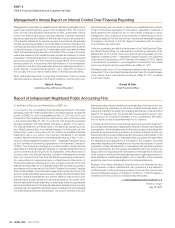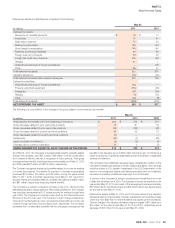Nike 2011 Annual Report Download - page 41
Download and view the complete annual report
Please find page 41 of the 2011 Nike annual report below. You can navigate through the pages in the report by either clicking on the pages listed below, or by using the keyword search tool below to find specific information within the annual report.
41NIKE,INC.-Form10-K
PARTII
Note1Summary of Signifi cant Accounting Policies
NOTE1 Summary of Signifi cant Accounting Policies
Description of Business
NIKE,Inc. is a worldwide leader in the design, marketing and distribution of
athletic and sports-inspired footwear, apparel, equipment and accessories.
Wholly-owned NIKE subsidiaries include Cole Haan, which designs, markets
and distributes dress and casual shoes, handbags, accessories and coats;
ConverseInc., which designs, markets and distributes athletic and casual
footwear, apparel and accessories; Hurley InternationalLLC, which designs,
markets and distributes action sports and youth lifestyle footwear, apparel
and accessories; and Umbro International Limited, which designs, distributes
and licenses athletic and casual footwear, apparel and equipment, primarily
for the sport of soccer.
Basis of Consolidation
The consolidated fi nancial statements include the accounts of NIKE,Inc. and
its subsidiaries (the“Company”). All signifi cant intercompany transactions and
balances have been eliminated.
Recognition of Revenues
Wholesale revenues are recognized when title passes and the risks and
rewards of ownership have passed to the customer, based on the terms of
sale. This occurs upon shipment or upon receipt by the customer depending
on the country of the sale and the agreement with the customer. Retail store
revenues are recorded at the time of sale. Provisions for sales discounts, returns
and miscellaneous claims from customers are made at the time of sale. As of
May31,2011 and 2010, the Company’s reserve balances for sales discounts,
returns and miscellaneous claims were $423million and $371million, respectively.
Shipping and Handling Costs
Shipping and handling costs are expensed as incurred and included in cost
of sales.
Demand Creation Expense
Demand creation expense consists of advertising and promotion costs,
including costs of endorsement contracts, television, digital and print advertising,
brand events, and retail brand presentation. Advertising production costs are
expensed the fi rst time an advertisement is run. Advertising placement costs
are expensed in the month the advertising appears, while costs related to
brand events are expensed when the event occurs. Costs related to retail
brand presentation are expensed when the presentation is completed and
delivered. A signifi cant amount of the Company’s promotional expenses result
from payments under endorsement contracts. Accounting for endorsement
payments is based upon specifi c contract provisions. Generally, endorsement
payments are expensed on a straight-line basis over the term of the contract
after giving recognition to periodic performance compliance provisions of the
contracts. Prepayments made under contracts are included in prepaid expenses
or other assets depending on the period to which the prepayment applies.
Through cooperative advertising programs, the Company reimburses retail
customers for certain costs of advertising the Company’s products. TheCompany
records these costs in selling and administrative expense at the point in
time when it is obligated to its customers for the costs, which is when the
related revenues are recognized. This obligation may arise prior to the related
advertisement being run.
Total advertising and promotion expenses were $2,448million, $2,356million, and
$2,352million for theyears ended May31,2011,2010 and 2009, respectively.
Prepaid advertising and promotion expenses recorded in prepaid expenses
and other assets totaled $291million and $261million at May31,2011
and2010, respectively.
Cash and Equivalents
Cash and equivalents represent cash and short-term, highly liquid investments
with maturities of threemonths or less at date of purchase. The carrying
amounts refl ected in the consolidated balance sheet for cash and equivalents
approximate fair value.
Short-Term Investments
Short-term investments consist of highly liquid investments, including commercial
paper, U.S. treasury, U.S. agency, and corporate debt securities, with maturities
over threemonths from the date of purchase. Debt securities that the Company
has the ability and positive intent to hold to maturity are carried at amortized
cost. At May31,2011 and 2010, the Company did not hold any short-term
investments that were classifi ed as trading or held-to-maturity.
At May31,2011 and 2010, short-term investments consisted of available-
for-sale securities. Available-for-sale securities are recorded at fair value with
unrealized gains and losses reported, net of tax, in other comprehensive
income, unless unrealized losses are determined to be other than temporary.
The Company considers all available-for-sale securities, including those with
maturity dates beyond 12months, as available to support current operational
liquidity needs and therefore classifi es all securities with maturity dates beyond
threemonths at the date of purchase as current assets within short-term
investments on the consolidated balance sheet.
See Note6— Fair Value Measurements for more information on the Company’s
short term investments.
Allowance for Uncollectible Accounts
Receivable
Accounts receivable consists primarily of amounts receivable from customers.
We make ongoing estimates relating to the collectability of our accounts
receivable and maintain an allowance for estimated losses resulting from
the inability of our customers to make required payments. In determining
the amount of the allowance, we consider our historical levelof credit losses
and make judgments about the creditworthiness of signifi cant customers
based on ongoing credit evaluations. Accounts receivable with anticipated
collection dates greater than 12months from the balance sheet date and
related allowances are considered non-current and recorded in other assets.
The allowance for uncollectible accounts receivable was $124million and
$117million at May31,2011 and 2010, respectively, of which $50million
and $43million was classifi ed as long-term and recorded in other assets.
Inventory Valuation
Inventories are stated at lower of cost or market and valued on a fi rst-in,
fi rst-out (“FIFO”) or moving average cost basis.
Property, Plant and Equipment and Depreciation
Property, plant and equipment are recorded at cost. Depreciation for fi nancial
reporting purposes is determined on a straight-line basis for buildings and
leasehold improvements over2 to 40years and for machinery and equipment
over2 to 15years. Computer software (including, in some cases, the cost
of internal labor) is depreciated on a straight-line basis over3 to 10years.
Impairment of Long-Lived Assets
The Company reviews the carrying value of long-lived assets or asset groups to
be used in operations whenever events or changes in circumstances indicate
that the carrying amount of the assets might not be recoverable. Factors that
would necessitate an impairment assessment include a signifi cant adverse
























